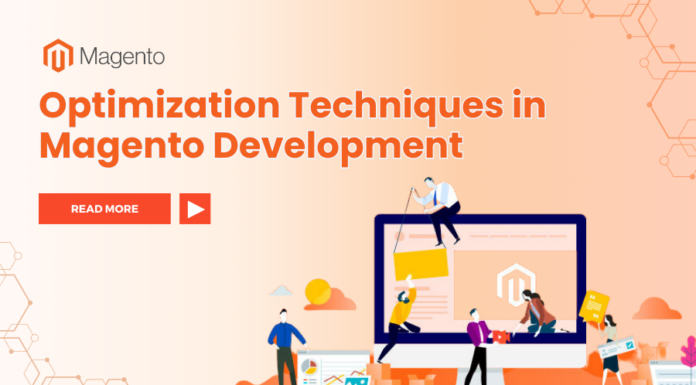
The term Magento no longer feels estranged. Whether you are a tech-savvy geek or not, Magento’s popularity is growing at a fanatic pace. And let me tell you this, the particular trend doesn’t seem to slow down anytime soon. The Magento Bandwagon is pretty huge, more like a banyan tree featuring a wide range of terms and concepts( its branches). One of its attention-grabbing branches that have been catching the eye a lot lately is “Magento Headless”.
The following post focuses on what is Magento Headless? How it works? How is Magento headless beneficial for businesses in the long run? Why should one be using Magento headless for their respective eCommerce stores? And how much does Magento headless development cost and so more? Basically, the post says it all about when it comes to Magento Headless. So just sit back, relax and read away. I am sure in the end you will definitely find the post worth your time.
Table of Contents
I. So, WHAT IS HEADLESS MAGENTO?

One of the obvious yet crucial questions to consider is what is headless Magento. Usually, the term “Headless“ seems to be pretty much haunted or terrifying but if we see the eCommerce realm, the term seems to be one of the leading buzzwords. Headless eCommerce platforms are the ones that ensure your store turns out to be quick, innovative, and scalable in the long run.
In fact, it may quite interest you to know that according to Forbes headless Magento seems to have managed to attract more than $1.65 billion over a couple of years. Quite an achievement isn’t it?
No wonder some of the most popular brands such as Nike, Target, Overstock, Redbox, and Under Armour have already begun evangelizing the concept more than ever. Still, confused about what is headless magneto? Here’s another example for you! Have you ever used a virtual reality headset? If yes, you know exactly with such a headset, you can seamlessly fly, ski down, and experience some of the best moments sitting right then and there. Of course, you are doing different things but not physically. Similarly, headless Magento (Adobe) enables you to experience such different situations without you being there physically.
Did you know that Magento is often known as a monolithic platform? For the non-techies, a monolithic platform is said when both the backend and front end tend to stick together. When we choose headless Magento, it surely means the backend will be used separately as a content management system and the frontend will be highly considered for a better user experience.

Earlier what used to happen was, everything affects everything. I mean if you make even a small change, it will affect another and this will lead to huge chaos and failure of the entire project. On the contrary, with headless Magento, any change made makes sure that everything else is not compromised. Also, as mentioned earlier, here both the backend and frontend are separated which means there is no scope for chaos and mess.
II. HOW HEADLESS MAGENTO COMMERCE WORKS
Basically, headless Magento relies on three independent pillars; Frontend, backend, and API. One of the basic yet crucial differences between a monolithic website and a headless Magento website is that both the frontend and backend stop supporting each other. Now due to this earlier, people used to face several issues such as online stores being in constant need of optimization. Since they used to work pretty slowly, shopping from mobile could be quite daunting for example the header might appear extremely big, regular maintenance, customization, and scaling, severe bloating of the code and whatnot!
After the inception of Headless Magento and with the help of different Magento development tools, all these mentioned issues have been resolved successfully. In addition to addressing all these issues, headless Magento also assists in increasing the speed of the store, adaptable UI/UX, and acceleration of the entire development process.
Above all, headless Magento architecture has the potential to prepare online merchants for what we will be experiencing tomorrow. And what’s in the future? People will prefer shopping via different connected devices. No kidding! With the help of headless Magento, small heads can be plugged and developed in quite a short span. So on and above you have nothing to lose!
III. PROS AND CONS OF HEADLESS MAGENTO
3.1. Why should use Magento Headless for your e-Commerce Store?
It may quite interest you to know that headless Magento and eCommerce tend to complement each other like chocolate and peanut butter; heaven in its own way! Further below I would like to mention certain advantages of using Headless Magento and why you should be considering this for your eCommerce store right here and right now!

#1 Amazing Omnichannel Experience
One of the obvious benefits of using headless Magento is you are entitled to receive an amazing omnichannel experience. In other words, by using headless you can explore and expand to a wide range of channels in a pretty unified way. For example, how about testing new places to market your products? You see this is not limited to simple websites, mobile and tablets in fact here several other unconventional devices are present such as billboards, apple watches, IoT devices and so forth.
Earlier, different admin dashboards were used to upload and manage the content. Fortunately, the situation is not the same anymore. Coming back to headless Magento, all the screens are well-connected with Magento CMS so whether you want to upload content or upgrade it, everything can be well-taken care of seamlessly. In addition, when you are using the headless Magento technology you have the potential to design different front ends for mobile, desktop, and other display screens. By doing so you will be able to optimize the best experience for each device.
#2 Increased Customization
Another advantage of headless Magento worth considering is an increased amount of customization. Data and information is something that is pretty much available every now and then. And gathering tons and tons of data can be pretty tiresome or daunting. Fortunately, with headless Magento, there is a huge scope for seamless customization, and personalization resulting in an amazing shopping experience from the end user’s perspective.
And due to this, several opportunities seem to have been created such as sharing content across a wide range of platforms, creating as amazing marketing opportunities as you can, enhancing conversion rates, and simultaneously ROI.
It may also interest you to know that headless provides more and more flexibility and scalability, especially in regards to how the end users are and will be interacting with your site. Whether they are using conventional gadgets or the latest smart devices, the frontend layer can be changed without disturbing the backend procedures.
#3 Speed and Agility
After customization and personalization come speed and agility. As mentioned earlier, here both the frontend and backend are separated to a great extent. As a result, they become lightweight, speedy, and quite agile in comparison to other solutions. In fact, if we see from the developer’s point of view, optimizing here in Magento headless is pretty straightforward and seamless. In addition, you should know that headless commerce and progressive web apps(PWAs) pretty much go hand-in-hand and that’s the beauty of it.
Since there are pros, there must be cons too!!! And one shouldn’t ignore the cons too.
3.2. Cons to Consider
#1 Requires ample developer efforts
On and all, developing a headless Magento site is way more complicated even in comparison to a monolithic website. You see it requires creating custom themes & API, or even custom features.
In addition, maintaining a headless Magento takes more time and effort and requires a skilled, knowledgeable, and well-experienced team of developers who ensure that your website works smoothly.
#2 More time to market
Another drawback of headless Magento is the time to launch the product increases to a great extent. You see, as mentioned, there is a huge scope for personalization and customization and due to this the time to market increases a lot. Whereas developing a Magento website can be done within a span of a month and it can be accomplished within the predetermined time frame.
IV. SOME OF THE HEADLESS COMMERCE WITH MAGENTO PLATFORM EXAMPLES
- Magento with PWA Studio – One of the best examples of headless Magento is Eleganza. The fashion brand has its own website developed using headless Magento and the Magento platform combines with PWA Studio. Here every activity whether it’s buying a product or simply browsing can be conducted within a very short span of time.
- Highlight Features:
- – App-like experience without installing an app
- – 100% usage of GraphQL
- – Integration of numerous payment methods
- – Full report of sales, product views, etc
- – Quick and exact elastic search
- – Multi platforms
- – Offline mode
- – Personalization
- G-SP – Another interesting example of a headless Magento is G-SP. This one mainly sells parts and several other types of digital accessories. G-SP has offices in various locations such as Sweden, Holland, China and so more. This one comprises a headless PWA that not just offers a smooth experience but enhances loading speed by 2.7x.
- MAGENTO WITH VUE STOREFRONT – Have you checked the Zadig & Voltaire website? Another interesting example of headless Magento was built using the Vue Storefront framework and is considered as the newest headless Magento implementation.
- Technodom – Technodom is quite known in Mid-Asia. The website features more than 60,000 products and 4,000 categories. The backend is well-integrated using Akeneo PIM (Product Information Management) and ESB (Enterprise Service Bus) and the frontend comprises PWA. The headless architecture enables us to conduct different tasks seamlessly.
- Tauer Perfume – The last but certainly not the least one is Tauer Perfume. Earlier they used Magento 1.9, due to which optimizing Magento conversions was next to impossible. Fortunately, after the implementation of the new headless PWA front end, things became more simple and better.
V. HOW MUCH DOES MAGENTO HEADLESS DEVELOPMENT COST?
Well, to be precise the exact amount depends on your requirements. How complex or simplified your project is, the overall cost will vary from time to time. Down below I would like you to get acquainted with some of the major factors that will have a great impact on the Magento headless Development cost.
- Design of the storefront – How many storefronts are you willing to create? Do you think your UI/UX idea is complicated?
- PWA implementation – Will you be using PWA for the headless storefront to enhance performance and mobile experience.
- Custom Integration – Whether you are willing to add payment gateways, barcode scanners, ERP, CRM, PIM, etc.
- API Customization – The more complicated storefront is, it will require more pricing and customization.
In the digital age, most e-commerce stores are quickly catching up with the digital transformation process. And if you are looking to develop Headless Magento for your store but don’t know where to start. Landofcoder is confident to be a companion with your business in this optimization process.
Contact us now to get the most suitable solution for your project!
V. CONCLUSION
So on and all, opting for the headless architecture means you are bound to receive certain promising benefits for your store. So if you are willing to improve mobile performance, if you want more flexibility or experiment, if you want to update content constantly then go Headless. Without a shadow of a doubt choose Headless Magento.














![[SALE OFF] Discount 30% Off All Products On Christmas And New Year 2024 Christmas & New Year 2024 sale off from Landofcoder](https://landofcoder.b-cdn.net/wp-content/uploads/2023/12/xmas-banner-900-x-500-px-3-218x150.png)




